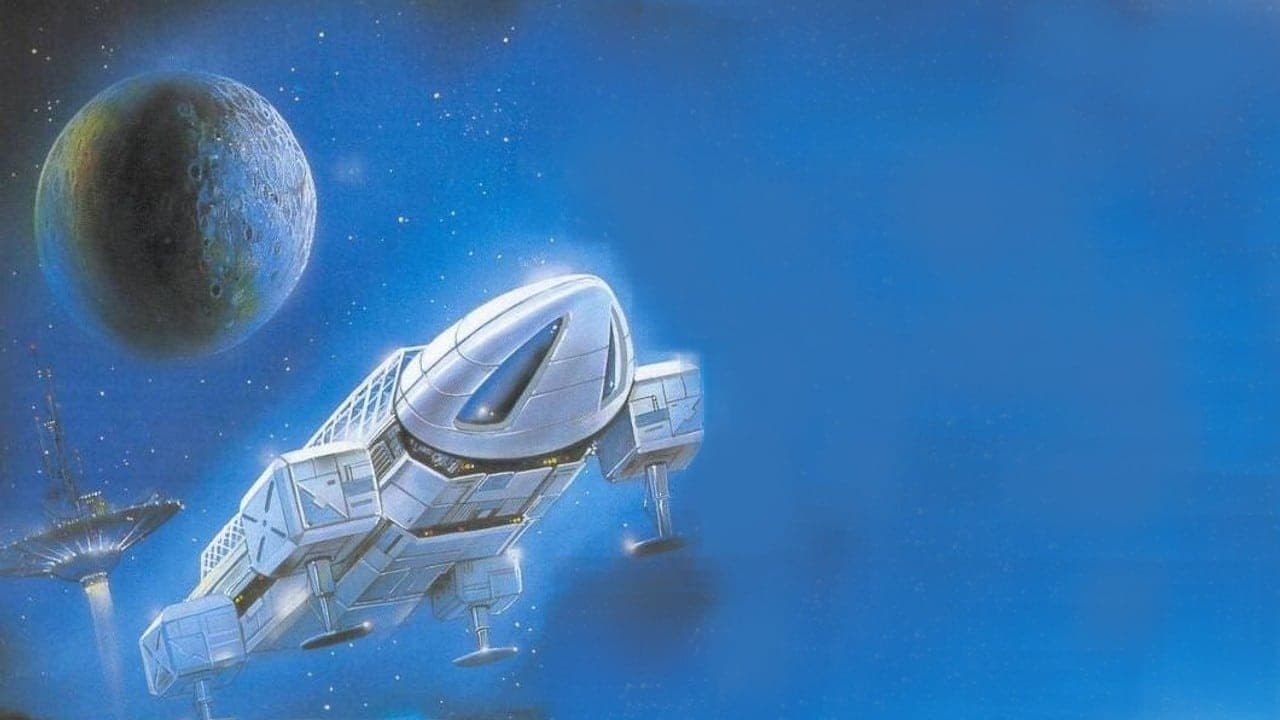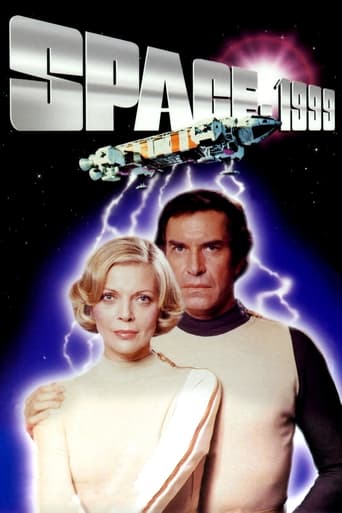

"Space: 1999" could best be described as a British version of "Star Trek." It was comparable to "Star Trek" in that it featured a crew which visited different worlds each week and experienced various adventures along the way. However, it differed from "Star Trek" in terms of premise. In "Star Trek," the crew traveled to different worlds in a ship which traveled faster than the speed of light because of warp drive. In "Space: 1999," the crew of Moonbase Alpha traveled to different star systems as a consequence of the moon having been blasted out of Earth orbit because of an accidental explosion."Space: 1999" was easily one of the most visually impressive science fiction series from the 1970's. The special effects were far above average by 1970's standards. The sets and costumes were among the best to be featured in a science fiction series. Overall, the series' visuals appeared to have been inspired by the movie, "2001: A Space Odyssey," which had been released only a few years prior to the launch of this series.One of the show's frequent shortcomings was its weak science. For example, the explosion in the first episode explained the moon's departure from Earth orbit; but in some respects, the series never fully explained how the moon and Moonbase Alpha were able to reach other star systems within short time periods without exceeding the speed of light. In another example, Maya's shape-shifting abilities introduced a number of science and logic issues. Weak science was common in 1970's science fiction television shows.The show underwent a few changes between seasons one and two. The show's atmosphere in season one was often much darker compared to that of season two. The costumes and sets were also slightly different between the two seasons. In some regards, the show's execution seemed to be stronger in season one than in season two.Overall, "Space: 1999" was an enjoyable series to watch. Although the show's science might not have always withstood close scrutiny, the show was still filled with memorable moments and unforgettable imagery. When the show's science failed, style generally triumphed over substance. "Space: 1999" was a fun and atmospheric science fiction series.
... View MoreThe conventional wisdom on this mid-70s sci fi offering from the prolific imagination of Gerry Anderson (THUNDERBIRDS, UFO) is, in a word...wrong. "Cerebral sci fi that 'jumped the shark' in season 2, rendering itself mindless and action-oriented". Well, no. Not precisely, no. Yes, season 2 did go after a larger audience and lower common denominator. But the truth of 1999 is completely opposite conventional wisdom. The only time they ever brushed greatness was in the maligned season 2...as children's sci fi. As adult sci fi, both seasons were failures, but the visuals, acting, and simplistic ideas of season 2 are ideal for a child in the 5-10 range, ready to take her or his (or ers) first steps into the mind-blowing universe of science fiction. To modern eyes, season 1 can't be called anything but plodding. It feels like it belongs in a museum, even though it was made almost a decade after the still-gripping STAR TREK. Is it cerebral? No. Being cerebral requires more than the appearance of cerebrality, dear Brits. There has to be genuine intellect at work. There are a handful of semi-gems. Real-life spouses of thirty-six years, Martin Landau and Barbara Bain star as leaders of Moonbase Alpha. In a nuclear waste accident, the moon is sent spinning off into space, where adventures await. The look of the show is pretty wonderful. The horseshoe-style lasers are absolutely classic. The eagles, their spaceships, are brilliant. Somehow both smooth and clunky, and boyohboy did the creators have a blast wrecking these things regularly. I don't know whether anyone's ever tabulated how many they lost, but it HAD to be more than they had in stock at the beginning. You could occasionally see the wires, but it's all so charmingly rendered that you buy into the reality fully. I had a toy eagle as a child, almost three feet long. The cockpit and engine sections disengaged to form a scout ship, something that never happened on the show. It would stand tall on a list of the five most brilliant toys of my youth. And don't let the strings fool you...time and again, you will be struck by how well-budgeted this show was. Rounding out the leads was Barry Morse as Professor Bergman, a gentle, thoughtful presence. The second season brought a great overhaul in the cast, music, and look. It's brighter and brisker, sexier and more playful, which feels great for about one episode. But the music is a travesty...the season 1 theme is a towering tribute to classic symphonic sci fi synth/guitar music that could ONLY have come out of the 70s, but the new theme song rolls off some cheesy assembly line. Sadly, the gentle wisdom of Barry Morse is also gone. The show falls prey to the insidious force of "youngicutifying" (a fate which also befell UFO), with dewy replacement characters Maya and Tony. For the first chunk of the season, it feels awful. But then, there comes a moment when you (and they?) finally stop taking the show seriously, and that moment is epiphanous. The possibility that this shift wasn't intentional is unsettling (the season 2 producer was Fred Freiberger, who also oversaw the much-derided last season of STAR TREK)...but through luck or a well-laid plan, it all slides into perfect children's sci fi, which can also make an adult in the right frame of mind chortle in delight. There are surprisingly few moments of regressive sexism or other such which a parent will have to pause and clarify for an eager child.
... View MoreThe UK critic Leslie Halliwell called this "'Star Trek' in all but name" and it's not hard to see why. As with the iconic 60s show, the rank or function of the various characters is indicated by the color of part of their clothing and much of the action takes place in a room dominated by a large screen. The lead characters are the sturdy commander, a scientist, the doctor, and a manly type, just as before. By 1975, "Star Trek" was long gone from our screens, except in syndication, and no quality sci-fi show had yet taken its place on TV. The time must have seemed propitious for another show of the kind.So ITC came up with this. In 1999, as portrayed in the show, the moon is being used as a dump for the waste generated by the nuclear power stations that keep Earth going. Problems arise, resulting in the biggest of those dumps exploding in such a way that the moon is sent flying off into deep space. Along for the ride are 300 or so people on Moonbase Alpha who must now fend for themselves against anything that space throws at them.I am told that such an explosion would shatter the moon rather than send it out of orbit, but I think I could swallow that goof if it were the only one and the show were otherwise acceptable. Unfortunately, there are so many things wrong with this that it's hard to know where to start. Sticking with the physics for a moment, the moon is shown moving between solar systems and even galaxies in a matter of days. OK, the USS Enterprise did this, but at least it had engines. How does the moon manage it?Some of the individual episodes work (my personal favorite is "War Games", where Alpha is seemingly devastated by an alien attack), but most don't, having resort to things like séances and crew members being taken over by the spirits of stars or long dead ancestors! Most episodes involve Alphans being killed, yet the base never seems short on people, although replacements are impossible to come by. And, just as with Star Trek's red shirts (the security personnel whose main role was to act as cannon fodder – four of them bite the dust in the episode "The Apple"), it is the purple-sleeved security guards who make up a disproportionate share of the victims.Meanwhile, the attempt to recreate the charming interplay between Star Trek's main characters falls flat on its face, a fact all the more remarkable when you consider that two of the leads , Martin Landau (Commander Koenig) and Barbara Bain (Doctor Russell), were married to each other at the time the show was made. Meanwhile, the "scientist" (Victor Bergman, played by Barry Morse) rarely seems to know anything and is reduced to spouting generalities. Only the "manly type", pilot Alan Carter, played by the ever reliable Nick Tate, gets it more or less right.Perhaps the worst mistake of all was the revamp carried out between seasons 1 and 2. Moonbase Alpha is scarcely recognizable as the same place. Some of the characters we know from the first season - Victor Bergman is one - have gone, without our being told why, while new ones appear with equally little attempt at explanation. The episodes, however, remain just as silly. Did nobody look at the title of "The Rules of Luton" and realize it just wouldn't work?On the plus side, the sets and model work are mostly good as is the music. Some of the guest appearances are striking too, notably that of Jeremy Kemp in the better-than-average episode "Voyager's Return". Despite everything, I have an odd affection for the show, especially the first season. But someone once said that it takes good science fact to make good science fiction. By breaking that, and other, rules way too often, this effort proves that sage individual right.Rating: 5/10
... View MoreWhat stands in my mind is how, eight to ten minutes before the end of nearly every episode, the society on a new planet encountered by the Alphans ends up being destroyed, usually at the hand of Commander John Koenig, because what it seeks does not meet with the life Alphans are used to. This was a weakness to otherwise intriguing stories that were not going to be mistaken for Star Trek.Although I remember too many things that left me scratching my head, even from the superior first season - why did the command centre have exterior windows that could be opened when the Moon was given an atmosphere? With all of the Eagles that crashed or were otherwise disabled, how did they always seem to be able to get another one aloft, and how were they fast enough, given the scramble of Alan Carter to keep up with the Moon when it first left Earth's orbit, to reach the base again when outside the gravity of the orb.The local TV station aired the first season Fridays at 7 pm, the same time slot that it had used for Star Trek a decade earlier. The second season was picked up by the CBC, but they threw it away by airing it Saturday afternoons at 3 pm. In the late 80s, it ended up on the children's channel YTV at about the same time, grouped with Blake's 7 and Red Dwarf. The TV regulator felt Space 1999 and Blake's 7 were too violent for a children's channel, and Red Dwarf being possibly too racy for daytime airing on that channel.It had potential, but it just seemed to have the need to sell in many markets so that it could pay its bills, rather than just to tell great stories. If it had told great stories consistently, it would have sold solidly and been a franchise comparable to Star Trek.
... View More